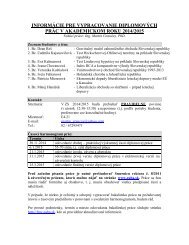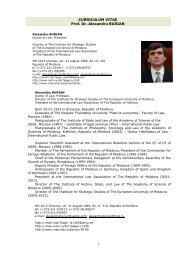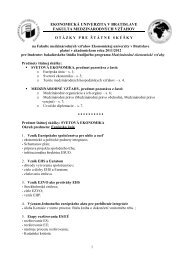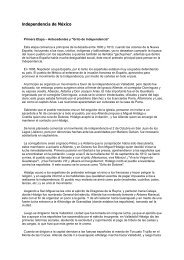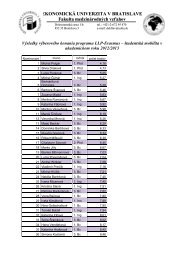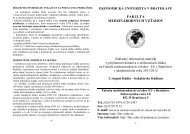4 - Fakulta medzinárodných vzťahov - Ekonomická univerzita v ...
4 - Fakulta medzinárodných vzťahov - Ekonomická univerzita v ...
4 - Fakulta medzinárodných vzťahov - Ekonomická univerzita v ...
You also want an ePaper? Increase the reach of your titles
YUMPU automatically turns print PDFs into web optimized ePapers that Google loves.
to underpin deregulation of the economy and encourage public investments. Besides the 1994package in the total amount of JPY 15.3 trillion, the government poured another JPY 17.4trillion into the economy in 1995. The packages reached more than 3% of the GDP, the biggestpart of them went on investments into social infrastructure and price decrease (JPY 5.9 trill.). 18Besides incentive packages the government tried to encourage domestic demand alsowithin general economic programmes, e.g. a new economic plan of 1995 for the period 1996-2000. In this plan structural reforms, deregulation of the economy, generation of new jobs,stabilization of the financial system and social field (improvements in housing, solution toproblems caused by aging of population, etc) were stressed. 19 The new 5-year plan wasfollowed by a programme of a structural reforms of 1996. Major principles of this programmewere e.g. support of the competition and newly also support of prospective businesses withinstable financial situation. Priority fields of structural reforms were financial sector,telecommunications, distribution systems, land treatment and housing, labour market andhealthcare.These measures led to the growth in private capital investments, whose pace recoveredfrom red numbers. Thanks to ongoing deregulation, electronic and telecommunicationsindustries accounted for the biggest growth in investments. Thanks to measures taken by theBOJ, government and G7 countries 20 , the yen started to devaluate gradually, which could beseen also in slowing down the import dynamics and increasing surplus of the trade balance.Despite the recovery, however, unemployment continued to grow (to 3.4% in 1996) and thegrowth in consumer prices oscillated around the zero border – see table 2.Although it seemed that the economy was recovering, negative factors appeared in thisphase as well. Besides JPY appreciation, continuing decrease in asset prices and earthquake inKobe region, there was a further decrease in the price level, public finances worsened, theamount of non-performing loans and assets grew and commencement of a financial crisis.2.1 Transition into deflation and liquidity trapAlready from the 1980s on Japan showed the lowest average rates of price levelgrowth in the OECD. The rate of inflation was gradually falling in all developed countries, inJapan the fastest. While the average annual rate of inflation was 2% in 1990-1994, it fell to0.49% in 1995. 21 In 1994 the rate of inflation (measured CPI) reached only 0.7% and in theensuing year -0.1%. Producers´ prices decreased in the long term from the mid-1980s. In the1990s the pace of their decrease was faster than the decrease in consumers´ prices and it was thesame with GDP deflator – see figure 3. Worries about negative effects of the deflation started toappear in Japan in this period. 22The long-term decline in prices was not expected in Japan by either official or privatestakeholders. Deflation is likely to be initiated by more factors on the side of growing aggregatesupply (growth in productivity and decrease in costs as a result of technological progress andstructural changes, later decrease in prices caused by restructuralisation of non-competitive18 OECD (2002): OECD Economic Survey – Japan 2001-2002, p. 53.19 Hsu, R. C. (1994): The MIT Encyklopedia of the Japanese Economy.20 Several coordinated interventions (following the G7 agreement) to strengthen USD andweaken JPY were undertaken in 1995. In contrast to the Plaza or Louvre Accords from the1980, president Clinton´s administration of this period strove for maintaining a strong USD. Astrong USD should have reflected a strong economy, therefore the USA were interested in a socalledstrong-dollar policy.21 Cargill, T. F. (2001): Monetary Policy, Deflation and Economic History, p. 119.22 Deflation can be defined as “decreasing of a price level or increasing of purchasing power ofa money unit”. According to Hindls, R. – Holman, R. – Hronová, S. a kol. (2003): Ekonomickýslovník, p. 71.136 ○ MEDZINÁRODNÉ VZŤAHY, 2012, 4



